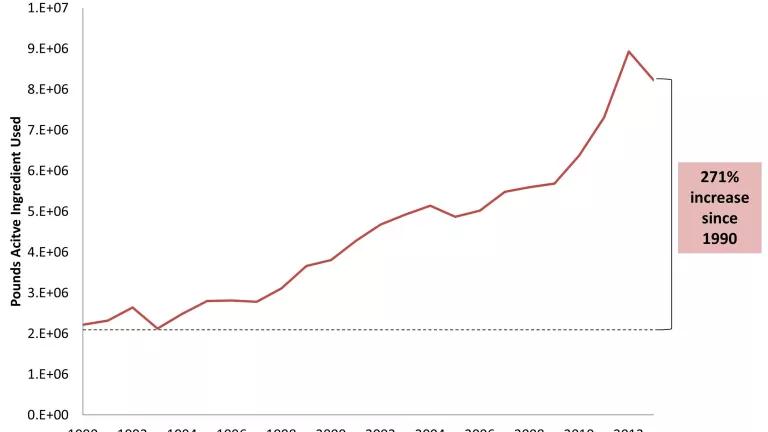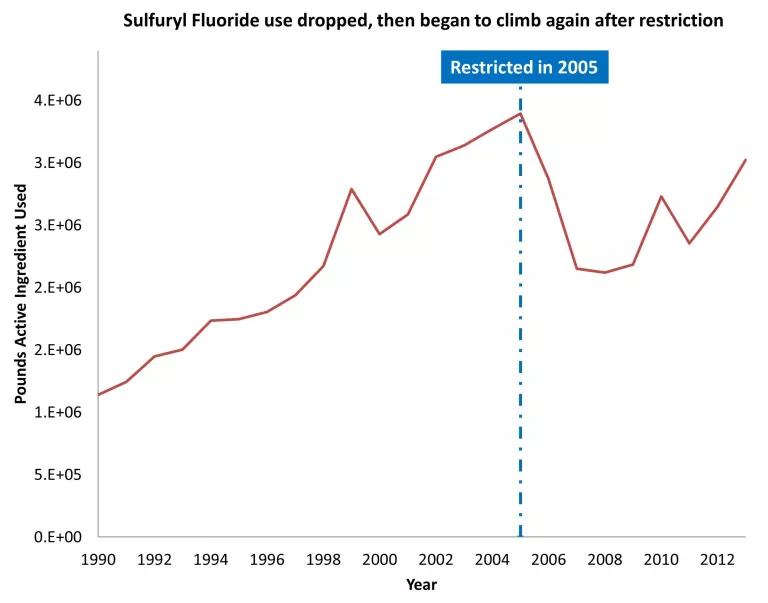
After years of delay on the neurotoxic pesticide chlorpyrifos, federal and state regulators have come out back-to-back acknowledging the hazards of this toxic chemical. But even with these announcements, communities are left waiting for meaningful protections.
On June 30, 2015, the US Environmental Protection Agency indicated that they are considering significant restrictions on chlorpyrifos-- which is indeed welcome news, but until those restrictions are in place, the need for strong statewide protections remains. And it might seem like the July 1, 2015, announcement from California that chlorpyrifos will officially be designated as "restricted use" in the state would fit that bill and place strict limits on the pesticide's use--but in reality, it's pretty weak. We ran some numbers to look into how protective this actually is, and the data from other pesticides doesn't support that the "restricted use" designation results in decreases in pesticide use. So unfortunately, there's little evidence to suggest that the "restricted use" designation will do much to protect California kids and communities from chlorpyrifos.
We analyzed California Pesticide Use Reporting (PUR) data from the last 25 years on ten restricted use pesticides and saw no pattern of sustained use decrease resulting from the restricted use designation. In fact, we saw the opposite trend for a number of the pesticides--the use increased significantly subsequent to the restricted use designation. This is concerning because increased use means more opportunities for potentially unsafe exposures for farm workers and nearby communities.
The analysis below shows that the restricted use designation is clearly insufficient to curtail use of hazardous pesticides including chlorpyrifos. Cal/EPA should move immediately to institute the real protections that communities need including expanded buffer zones, restrictions on application methods, and a plan for phasing out use of this very toxic chemical.
Restricted use pesticides applied near public schools
In 2014, the California Department of Public Health (DPH) published a report on pesticides of public health concern used near public schools.
In the table below, we took the top 10 pesticides of public health concern, by pounds applied within ¼ of schools in the 15 counties assessed, from the DPH schools report. Then, we analyzed PUR data on the 6 pesticides that are "restricted use" to determine how the use of the pesticide has changed since restriction. We looked at use in 2013, the most recent year of PUR data available, compared to when the pesticide was restricted to figure out if the use increased, decreased or stayed about the same. Some of the pesticides were restricted before the state started collecting PUR data, so in those cases we just compared the 2013 use to 1990, which is the first year that PUR data was collected.
Top 10 pesticide active ingredients, by pounds applied within ¼ mile of schools in the 15 counties assessed, 2010; with information on restricted use added.
Data from CA PUR
|
Rank |
Name |
Year designated as restricted |
% change in pounds used from the year after restriction compared to 2013* |
|
1 |
Chloropicrin |
1960 |
+271%* |
|
2 |
1,3-dichloropropene (Telone) |
1978 |
+146%* |
|
3 |
Methyl bromide |
1973 |
-83%* |
|
4 |
Metam-sodium |
1994 |
-68% |
|
5 |
Metam Potassium (Potassium n-methyldithiocarbamate) |
2000 |
+1940% |
|
6 |
Captan |
Not restricted |
|
|
7 |
Pendimethalin |
Not restricted |
|
|
8 |
Chlorpyrifos |
Not restricted |
|
|
9 |
Paraquat Dichloride |
1978 |
+38%* |
|
10 |
Malathion |
Not restricted |
*For pesticides restricted before 1990, numbers shown indicate % change in the pounds used since 1990
The analysis revealed that for 67% (4/6) of these restricted use pesticides, use has increased since they were restricted (chloropicrin; 1,3-dichloropropene; metam potassium; and paraquat).
As shown in the graph below, chloropicrin has been restricted since 1960 but nonetheless showed a pattern of almost continuous growth in use since 1990.
Other pesticides designated as "restricted use" in the last 15 years
We also looked at the 4 other pesticides that have been designated as "restricted use" by Cal/EPA in the last 15 years, shown in the table below (from the CA Code of Regulations, Title 3, Division 6, Chapter 2, Subchapter 4, Article 1, Section 6400).
Use trends for the four pesticides designated as restricted by Cal/EPA in the last 15 years.
Data from CA PUR
|
Name |
Year designated as restricted |
% change in pounds used from the year after restriction compared to 2013 |
|
Dazomet |
2000 |
+44% |
|
Sulfuryl fluoride |
2005 |
+5% |
|
Magnesium phosphide |
2008 |
+52% |
|
Phosphine gas |
2008 |
-32% |
For some pesticides, like sulfuryl fluoride, use dropped immediately following restriction but then began to climb again as shown in the graph below.

"Restricted use" permit requests rarely denied
Finally, the "restricted use" designation does give County Agricultural Commissioners the authority to protect sensitive sites, like schools, by denying permit requests for restricted use pesticide applications near such sites. To understand if this authority is likely to help protect sensitive sites, we looked at enforcement data from Cal/EPA to understand how often permit requests are granted or denied.
In 2012, County Agricultural Commissioners granted 99.6% of all "restricted use" permit requests (of 30,539 permit requests, 134 were denied), revealing that Commissioners rarely use their authority to block requests for "restricted use" pesticide applications.
Overall, this data together points to the fact that making chlorpyrifos "restricted use" will likely have little effect on its use--either the amounts used or where the toxic pesticide is used. Indeed, there is nothing in "restricted use" that prevents chlorpyrifos use from increasing, just like it did in 2013. That's the wrong direction for California kids and communities.
